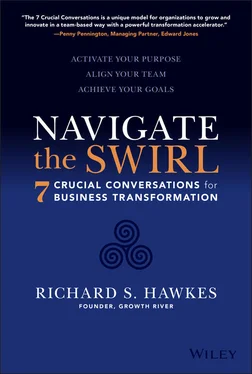But along with all of that messiness comes incredible potential. That's why, when we want to achieve things that matter, we form organizations: because we know that we can do so much more together than we could ever do alone. And not just by bending others to our will, but by working to unleash their creativity and intelligence. People can be difficult but they can also be original, innovative, caring, and independent. They can be complicated, but they can surprise you with their commitment and capabilities. Which brings us to the question that has spawned a thousand books about leadership: How do we get from messy, complicated, and dispersed to capable, creative, and aligned? If an organization is much more than a business, what's the best approach to managing it, leading it, and growing it? The answer starts with how we see it.
Metaphors matter. As storytelling creatures, when confronted with a complicated, multidimensional, somewhat abstract entity like an organization, we tend to look for images that help us to describe it and make sense of it. We need something we can visualize. And these metaphors we choose will inevitably shape not just the way we talk about our organizations, but how we respond to them and how we lead them.
For example, it's common for leaders and change-management experts today to talk about organizations as if they were machines or computers. Machines have parts, which either work or break down, in which case they need to be repaired or replaced. They have inputs and outputs. Sometimes, they need tune-ups, new engines, or software updates. It's a convenient metaphor, pleasingly concrete. There's just one problem: actual organizations don't work like machines. Businesses are not body shops. And people don't respond well to being treated like parts that either function well or are deficient. If you think simply replacing all your dysfunctional parts or installing the latest trendy management theory like a software update is the answer to building a high-performing organization, you will be in for a long, difficult journey.
One of the central shortcomings of the mechanistic approach is that it sees the whole as being simply the sum of the parts, and the parts as being essentially predictable and self-contained. As anyone who's tried to lead a team of people knows, this could not be farther from the truth. An organization is much more than the sum of the people involved—that's what makes it powerful, but also challenging to manage. And those people are anything but predictable, while being profoundly interconnected. In this sense, as in many others, the machine metaphor is a poor fit and gives rise to leadership approaches that are limited at best. And yet this metaphor—and the perspective and management methods it spawns—is surprisingly persistent in the business community today.
Metaphors matter . How we frame problems and opportunities in our organizations creates the expectations, solution-sets, and “possibility space” in which we operate. A limited metaphor tends to limit our thinking. So, if organizations are not machines, how might we understand them better? What metaphors or images might we adopt to help us describe and guide them? I've come to the conclusion that that best way to see—and lead—an organization is as a system . More specifically, as a complex, adaptive social system .
That may not be as conveniently concrete as a machine or a computer, but it's a more accurate and therefore more powerful way to understand the human dynamics involved. Organizations are not machines subject to immutable laws of physics, they are human systems subject to the more complex social dynamics of relationships. I've found that this shift of metaphor works with leaders and teams to release and make visible their mental frameworks and consequently opens the door for them to envision and lead transformations that otherwise might have seemed impossible. Leaders and team members must become systems thinkers —able to visualize and model the ways in which the elements of the system interact and transform. The Growth River approach to creating high-performing teams and companies is based on this fundamental premise: teams and organizations are complex, adaptive, social systems.
“Complex adaptive system” is a term that comes out of the science of complexity theory. It refers to any system—whether in the natural world, in technology, or in human culture—in which the behavior of the system as a whole cannot be explained simply by looking at the individual parts. It is a system that has something called swarm intelligence—a population of decentralized agents that interact with each other to self-organize around shared purpose and aligned behaviors. For example, think about an ecosystem, an ant colony, the flow of urban traffic, an economy, a language, the human immune system, the Internet, a cell, a nation. In each of these diverse examples, the system has its own properties that cannot always be predicted by understanding the parts. It exhibits self-organizing, or emergent, behavior. You could study an individual bee for years and never fully understand the behavior of a hive. You could analyze a single blood cell from every conceivable angle and not come close to grasping the functioning of the circulatory system. You could memorize every word of an unfamiliar language yet have no ability to use it to communicate.
Complex adaptive systems occur in the natural world and in the human world, but when it comes to human systems, we add the term social . In such systems, the complexity is increased by the fact that the system is made up of individual people, each possessing a degree of agency—the ability to choose, adapt, surprise, change direction, as well as create and collaborate in new and interesting ways. Each agent in this system has a unique mental and emotional universe, an interior, subjective world that influences their choices in ways that are hard, if not impossible, to predict or control. At times, that can make everything immensely more difficult and confusing, and yet, the good news is that it makes so much more possible.
A systemis a set of things that work together in a way that produces certain outcomes.
Systems thinkingis when you seek to identify and model the set of things within a system and the relationships between them so that you can accurately plan or produce target outcomes and identify performance improvement opportunities.
A complex adaptive social systemis a network of individuals that exhibits self-organizing properties and can adapt behavior purposefully, both individually and collectively, in response to changing circumstances.
One of the most remarkable things about human beings is our ability to intentionally organize around a shared goal or purpose and in so doing, to achieve things we could never do alone. You might be a brilliant medical scientist who invents a powerful new drug to cure cancer, but if it's just you in your lab, you won't save many lives. You need others to help you manufacture the drug, test it and ensure it's safe, sell it, distribute it, and so on. Or perhaps you're passionate about combating climate change and you come up with a way to generate more efficient energy from solar panels. If you only install it on your own roof, you aren't going to make much of a difference to net carbon emissions. But if you can create an organization to manufacture, sell, and promote your product to tens of thousands of households, you could have a significant impact.
Complex adaptive social systems include all manner of human groupings, from tribes, political parties, sports teams, and religious communities to terrorist groups, gangs, and cults. The term is fittingly applied to business organizations as well. A human organization does not behave like a collection of molecules interacting to create a cell. It doesn't pattern itself like a colony of bacteria, or even the complex interactions of plants, animals, insects, and climate that make up an ecosystem. Although it may have a lot in common with all these systems, the human element adds another dimension to the mix.
Читать дальше












